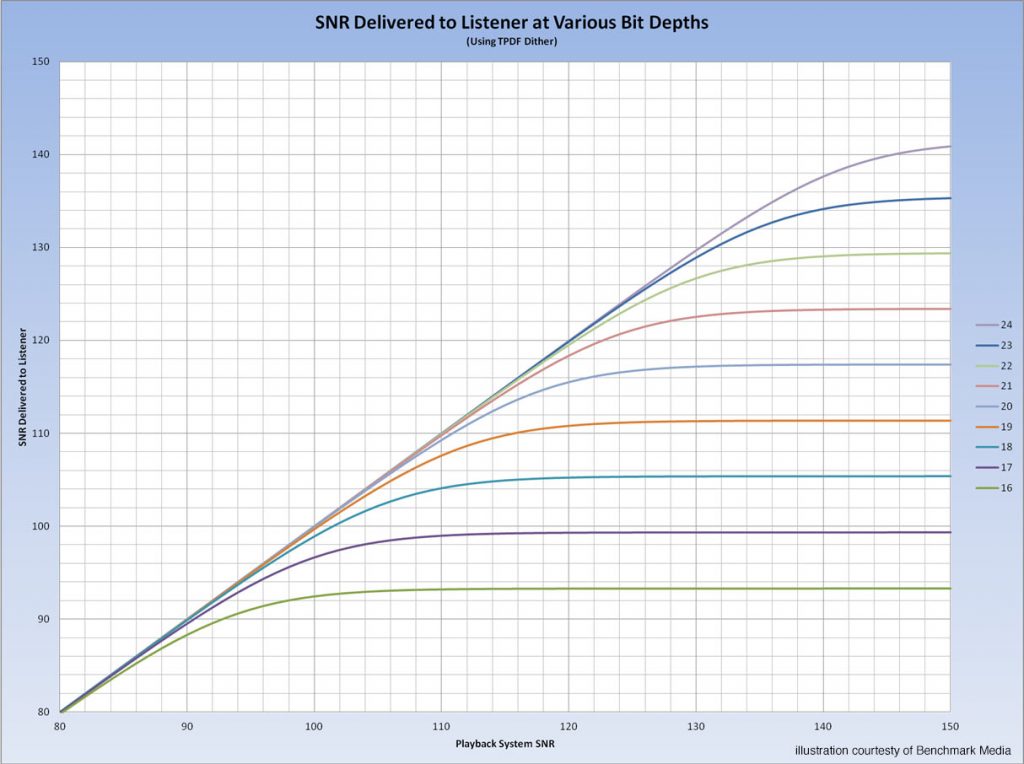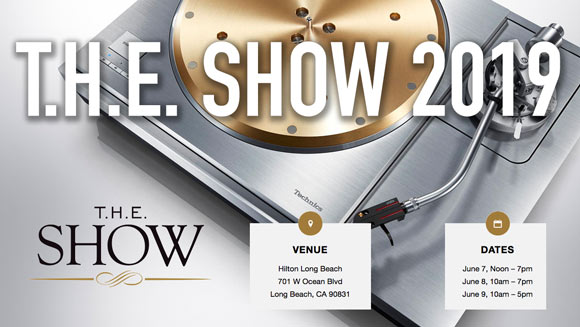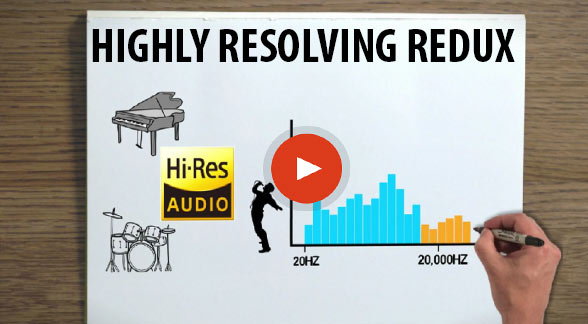Highly Resolving Redux
I’m really fortunate to have friends that are smarter than me. In many aspects of life, it’s great to be able to discuss and learn from people with different areas of expertise and life experiences. So when I authored a recent blog on “highly resolving” systems and whether they are necessary (you can read that article by clicking here), it was a welcome surprise to hear from one of the smartest people I know, John Siau, the principal designer of both analog and digital systems at Benchmark Media. I consider their DACs to be among the finest on the planet — equally at home in my mastering room all these years AND in my home system.
Benchmark supplied their DACs and power amplifiers for all of the 5.1 HD-Audio demos that AIX Records assembled at AXPONA shows. Benchmarks’ hardware and my recordings delivered a music experience unlike any demo at any trade show in the history of trade shows. Why do I feel confident in making that boast? Because the entire signal path from source recording to speaker output was truly capable of maintaining high-resolution specifications — a truly “highly resolving” system. Read on and see how John’s email clarifies the discussion with specifications and insights from a world class designer.
++++++++++++++++++++++++++++++++++++++++++++++++++++++++++++++++
50% OFF Sale Extended For 3 More Days!!

Special 50% Discount for Blog Readers!
Come by the T.H.E. Show this weekend in Long Beach or order through the website to take advantage of this deal through the weekend. NOTE: This discount applies only to the paperbook book not the eBook.
Visit Music and Audio: A User Guide to Better Soundto get your copy today!
++++++++++++++++++++++++++++++++++++++++++++++++++++++++++++++++
Below is John’s contribution to this important topic (reprinted here with his permission):
Mark,
It is not a matter of fancy cables, and esoteric tweaks. It is all about the math (MW bolded). If anyone hears the difference, it probably will not be on the basis of the frequency response.
There are exactly three potential advantages provided by high-resolution audio:
1: An increased high frequency limit
2: An increased immunity to the clipping of intersample peaks
3: An increased SNR
Items 2 and 3 are audible under the right circumstances. Item 1 may never or almost never be audible. Here is my reasoning:
1: High Frequency Limit
Very few listeners will have transducers that extend beyond the 22 kHz limit of the CD format. The exception will be listeners with good headphones or very good speakers. But, most listeners can’t hear beyond 20 kHz. You will need the rare combination of someone will excellent hearing beyond 22 kHz who is listening through good transducers. You will also need significant musical content above 22 kHz (at sufficient levels). This is going to be too small a group to be statistically significant. The size of this group is likely to be 0. You need to put some young but trained ears into some good headphones and play the right source material.
2: Clipping of intersample peaks
The worst-case clipping is caused by a tone at 1/4 of the sample rate that is shifted 45 degrees relative to the sampling clock. This tone can reach 3.01 dB over 0 dBFS before the maximum digital codes are reached. This 0 dBFS + condition can happen 1000s of times on a single CD track. When upsampled in a sigma-delta D/A converter, these intersample peaks can cause clipping in the D/A converter. This often causes a DSP overload that creates a burst of IMD. This artifact is audible, but completely avoidable. The Benchmark DAC2 and DAC3 converters do not have this artifact at any sample rate. Most other D/A converters have this artifact. This will tend to make high sample rates sound better unless you are using Benchmark DAC2 or DAC3 converters. Here is a case where a better system makes all sample rates sound good. Most systems will make 44.1 sound worse than it should.
3: SNR:
A few quick calculations will show that the listeners will need playback systems with at least an 87 dB SNR and they will need to play the audio at peak levels exceeding 93 dB SPL. Otherwise, it is mathematically impossible to hear the noise advantage of anything beyond 16 bits.
If the listener’s system has a playback SNR of 87 dB and it is playing at a peak SPL exceeding 93 dB, they would be listening for a very small 1 dB difference in the noise floor. If the listener’s system has a much better SNR, then the task will be much easier (assuming they turn the volume up high enough the hear the 16-bit TPDF noise). If their system is absolute state of the art, it will have a 130 dB SNR. If they set 0 dBFS to 130 dB SPL, the 16-bit dither noise will be reproduced 37 dB above the threshold of hearing and would be very audible. On such a system, you could easily hear the differences in word lengths until you reach 23 bits. But, you would go deaf listening to the music unless the music had an unusually high crest factor or was recorded at a very low level. You would need to turn the system down to listen to the music. The more you turn it down, the less difference you will hear.
Here is the math (nothing here that you do not already know):
SNR in dB for a digital channel is (6.02*N)+1.76 measured over the entire Nyquist bandwidth of the channel.
If the signal is TPDF dithered, subtract 4.77 dB
Therefore, for TPDF channels we have:
(6.02*N)+1.76-4.77=(6.02*N)-3.01 dB
At 16 bits this gives 93.31 dB. We will round to 93 for the sake of discussion.
In order for a listener to detect a difference on the basis of SNR, all three of the following conditions must be met:
1. The recorded noise must be lower than the channel noise of the 16-bit system (-93 dBFS).
2. The channel noise of the 16-bit system must be played at a level that exceeds 0 dB SPL. Therefore, the SPL at 0 dBFS must exceed 93 dB.
3. The noise produced by the playback system must not be more than 6 dB higher than that of the 16-bit system. This noise summation will produce just detectable noise difference of 1 dB. Therefore the SNR of the playback system must exceed 93-6 = 87 dB.
Item 1: You are controlling item 1 with your choice of source material.
Item 2: The listener may or may not choose to exceed a peak SPL of 93 dB during the test. The peak SPL chosen by listeners will be higher on uncompressed material due to the higher crest factor. You are choosing the source material and can experiment with different crest factors.
Item 3: This is a big problem! Many “high-end” systems are not capable of delivering an 87 dB SNR. There are almost no speaker systems that can do better than about a 105 dB SNR because of amplifier limitations (the Benchmark AHB2 is a notable exception).
A few state-of-the-art systems can deliver a 130 dB SNR to headphones if all of the components are properly gain staged (Benchmark DAC3 driving a Benchmark HPA4 is one example).
A Benchmark AHB2 power amplifier driven by a Benchmark DAC3 can deliver a noise-free 130 dB SPL if it is driving speakers that have a sensitivity of at least 104 dB at 2.83 Vrms. We have a few customers with such systems, but there are less than 10 examples worldwide.
Here is a chart that I created. It sums the digital channel with the playback system noise to calculate the SNR that will be delivered to the listener. I included bit depths of 8 through 24 bits. Find your playback SNR or peak playback SPL (whichever is lowest) on the X axis and then find the y value for each bit-depth curve. If the lines are separated at your SNR or SPL, then you will be able to hear a change in the noise floor.

Example 1: If you have a noise-free playback level of 100 dB SPL (find 100 dB on the X axis), you should be able to hear changes for bit depths up to 19 bits. Beyond 19 bits, there will be no audible (or measurable) improvement.
Example 2: If you have a system that can achieve a noise-free playback level 130 dB SPL, and you are playing it that loud, find 130 dB on the X axis. You should be able to hear the noise differences for bit depths up to 23 bits. Beyond 23 bits, there will be no audible (or measurable) improvement.
Example 3: You have a system that has a SNR of 87 dB and you are playing it at a peak SPL of 100 dB. Take the lower of the two (87 dB) and find this on the X axis. Any bit depth above 16 bits will produce a 1 dB reduction in the noise relative to the 16-bit system. Longer word lengths may be just noticeable, but 17 bits will give the same performance as 24 bits.
Example 4: 100 dB SNR playing at a peak level of only 80 dB. Find 80 dB on the X axis. Changes should be noticeable up to a bit depth of 14 bits.
I should also note that a given D/A converter may deliver different performance at different sample rates. They often use entirely different filters and may have entirely different THD performance. The filters may have distinctly different phase response and this can be perceived as a change in frequency response. Early oversampled converters performed poorly at higher sample rates due to poor stop band attenuation. To mitigate this problem, I would suggest separating the word length tests from the sample rate tests. Change one parameter at time. Test 44.1/16 against 44.1/24. Then test 44.1/24 against 192/24. This will tell you if the audible differences are related to word length, sample rate or both. Once this has been established, you could look at 18, 20, and 22 bit depths to determine the threshold of audibility. You could also run a separate test to determine the audibility of sample rate is linked to intersample clipping or to bandwidth.
John Siau
I’ll follow up with comments and annotations tomorrow. I especially like the idea of isolating the upcoming research study with independent increases in sample rate and word lengths.
+++++++++++++++++++++++++++++++++++++++++++++++++++++++++++++
Don’t forget that I’ll be exhibiting at the T.H.E. Show (The Home Entertainment Show) this weekend at the Long Beach Hilton. Please come by and say hello.

+++++++++++++++++++++++++++++++++++++++++++++++++++++++++++++++
Looking for additional expertise
Some of you may have noticed that both AIX Records and iTrax.com have been down for a long time. I’m in the midst of moving to a less costly server and progress has been painfully slow.
I will be redoing the entire AIX Records website over this summer and iTrax.com will be incorporated into that new site. In the meantime, I have an immediate need. There is about 3.7 terabytes of high-resolution music files on a German server that I want to move to the Google cloud (it’s less expensive and more powerful). I have messed around in Terminal and SSH (I can log on but don’t seem to be able to find the files) but lack the expertise to get the files moved using gsutil or something equivalent. If there is anyone out there with experience doing this sort of thing…I would welcome your help. I have ten days to accomplish this transfer before the German server is taken offline. You can contact me at mwaldrep@aixmediagroup.com.
Thanks.
UPDATE: I have managed to offload ALL of the music files and will be uploading them to the Google Cloud asap.

